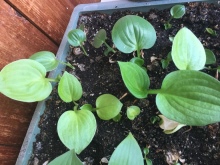Hosta "Big Daddy": description, planting, care and reproduction

Hosta belongs to the perennial herbaceous plants of the Asparagus family. In the wild, it is found in the Far East, Japan and Southeast Asia. Previously, the genus of these plants was called funku, which was formed from the surname of the botanist from Germany Heinrich Funk. Of the European countries in the 19th century, the hosta gained the greatest popularity in England. Today, it is a widespread ornamental plant, which is appreciated for its beautiful leaves and trouble-free growth even in the most shady parts of the garden.
Appearance
Hosta "Big Daddy" is a large hybrid plant, reaching a height of more than 60 cm and a width of more than 1 meter. From English the name Big daddy is translated as "Big Daddy". This hybrid was registered in the US state of Massachusetts in 1978. "Big Daddy" has a domed compact bush shape. Cup-shaped dense leaves in the center of the plant are painted in dark blue and have a silvery chalk bloom, but by the end of the season they turn noticeably green. The length of the leaves is about 30 cm, the width is 28-29 cm. Peduncles 70-120 cm high appear in July-August, according to the description they are whitish in color, without a pattern and have no odor. Flowers funnel-shaped or funnel-bell-shaped, usually collected in racemose inflorescences.


How to plant and care properly?
Planting of Big daddy hosts is carried out in early spring or autumn in a wide planting hole; it is recommended to use a mixture of compost, humus, peat, sand. Growth buds must be at the soil level. It should be borne in mind that bushes tend to grow strongly, so hybrids should be planted at a distance of 60 cm from each other, after planting, the land near the plant must be watered and mulched... This variety is not particularly picky about the composition of the soil, however, loose, slightly acidic and moderately moist variants are preferable. The host loves moisture, but not dampness; adult plants tolerate drought well, since their roots penetrate the ground very deeply.


These hosts prefer shady and semi-shady areas. They grow very slowly. Mineral fertilizers should be applied periodically. Plants tolerate winter frosts well, but in autumn, the soil should be covered with insulating material, since the roots are located superficially.
In general, it is a healthy plant that is resistant to pest infestation, the most dangerous of which are caterpillars and slugs.

Breeding secrets
Reproduction of Big Daddy hosts can be done in the following ways.

- Sowing seeds. This is a laborious process that breeders most often use. Seeds are sown in spring in small pots to a depth of no more than 7 mm, then sprinkled with a layer of perlite and compact the earth. In a few weeks, when shoots appear, the crops are kept at a temperature of 20 degrees Celsius. A pick should be carried out after the formation of the first leaf, and then gradually take the plants out for a short time, accustoming them to the sun's rays. Sowing seeds directly into open ground is possible only at the beginning of June.
- Cuttings. In May-June, young shoots of hosts with a heel are cut off with a sharp instrument. The leaves are cut in half so that the juices do not evaporate. The shoots are then planted in shade or shaded. Water the cuttings every day until rooting is complete. They may look sluggish at first, but gradually take on an attractive appearance.
- Division of the rhizome. This method is basic for the host. Overgrown 4-year-old bushes are separated in spring (April to May) or autumn (early September). It is possible to separate the planting material without digging up the entire plant, but it is preferable to divide it by completely digging the bush. Plants obtained in this way are planted at the same depth as the main host.



Application in landscape design
Hosta Big daddy looks very nice when single planting against the backdrop of green lawn. It is ideal for flower beds and borders. This variety is in harmony with not very tall conifers, as well as ferns, daylilies, lupins. "Big Daddy" looks great when planted near water bodies and in a rock garden among the stones. This large hosta can easily decorate tall plants with unattractive leaves. Hosta "Big Daddy" is an unpretentious perennial. It has a very impressive look, especially when combined with other ornamental plants. With the right care, these hosts can grow in one place for over 20 years, making an exquisite decoration for the shady space of any garden.



For more information on growing and caring for the Big Daddy hosta, see the next video.







































































































The comment was sent successfully.